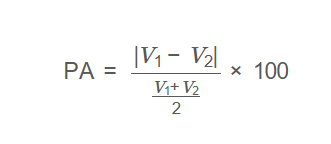 Home
Home
 Back
Back

Definition: The Percent Agreement Calculator computes the percentage of agreement between two values, representing the relative difference between them as a percentage of their average. It quantifies how much two measurements or ratings differ.
Purpose: It is used in fields like psychology, sociology, and quality control to assess the consistency or discrepancy between two measurements, ratings, or observations, aiding in reliability analysis and process evaluation.
The calculator uses the following formula:
Formula: \[ \text{PA} = \frac{|V_1 - V_2|}{\frac{V_1 + V_2}{2}} \times 100 \] Where:
Steps:
Calculating percent agreement is crucial for:
Example: Calculate the percent agreement for two measurements: \( V_1 = 25 \), \( V_2 = 20 \).
Q: What is percent agreement?
A: Percent agreement (\( \text{PA} \)) measures the relative difference between two values as a percentage of their average, indicating how much they differ.
Q: How does this percent agreement formula differ from other definitions?
A: This formula measures the relative difference as a percentage. Other definitions, like inter-rater reliability, may count exact matches divided by total observations. This calculator uses the relative difference approach.
Q: Can percent agreement exceed 100%?
A: No, percent agreement is typically between 0% and 100%, though this formula can yield values above 100% for large differences (e.g., if \( |V_1 - V_2| > \frac{V_1 + V_2}{2} \)).
Q: What is a good percent agreement?
A: Lower values indicate less agreement (more difference). Context matters, but values below 10% suggest high similarity, while higher values indicate greater discrepancy.